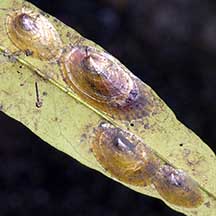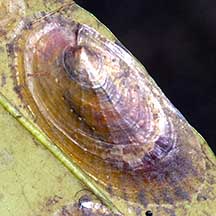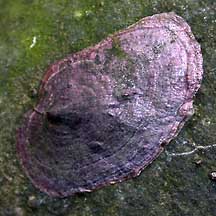 |
|
| bivalves text index | photo index |
| Phylum Mollusca > Class Bivalvia > Family Anomiidae |
| Mangrove
jingle clam Enigmonia aenigmatica Family Anomiidae updated May 2020 Where seen? Like shiny scales, this animal is commonly seen in groups of a few individuals on leaves, trunks and roots of mangrove trees. It usually settles at a height between the high spring and high neap tide. Features: To about 3cm. The two-part shell is thin and lustrous. Usually oval, sometimes irregular. Colours range from beige, purplish to blackish. One valve is stuck to a hard surface (leaves, tree trunk, roots) and this valve is usually flat. The other valve is usually slightly conical in shape. The valve that is stuck to the hard surface has a notch or hole in it. The animal secretes byssus threads through the hole to stick to the hard surface. Sometimes called the tree-climbing clam, the young animal is more mobile and can move around by using its extendible foot. A young animal is relatively broader than a more mature animal. |
 Lim Chu Kang, Jan 04 |
 |
 Seletar, Jun 02 |
| Mangrove jingle clams on Singapore shores |
On wildsingapore
flickr
|
Links
|